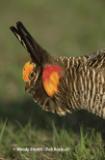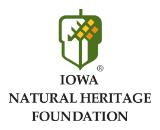Prairie Chickens Gain Habitat by Iowa Natural Heritage Foundation
Considered one of Iowa’s most unique natural treasures, the public land within the 1300-acre Kellerton Grasslands Bird Conservation Area (BCA) is expanding. The Iowa Natural Heritage Foundation (INHF) purchased the 80-acre addition in 2005 and then transferred it to the Iowa Department of Natural Resources (DNR).
The new addition is sure to be welcomed by the site’s star species, the Greater Prairie Chicken. The partners hope the addition will further boost the bird’s small populations within Iowa. Though the prairie chicken’s signature “booming” sound once echoed across Iowa prairies, over-hunting and habitat destruction led to their complete absence here for nearly 50 years. The birds were successfully reintroduced to the Ringgold Wildlife Area in 1987, and their population is slowly rebuilding.
“The mission of this site is to provide habitat for open grassland birds and this includes the prairie chicken,” said Mel Moe, a wildlife biologist with the Iowa Department of Natural Resources in Mount Ayr, Iowa. “Kellerton is home to the largest existing prairie chicken flock in Iowa. This tract of land plays an important role in continuing the revitalization of the species to the area.”
Up to 40 prairie chickens have been seen in the Kellerton area. Due to their growing population, this BCA now hosts Iowa’s largest known “booming” grounds. Here male prairie chickens attempt to attract females by performing an unusual mating dance and making a loud booming sound, using air sacs in their throats.
As a result, the site draws still another species. Bird watching enthusiasts flock here every spring to witness the display. A viewing platform adds a special touch, allowing visitors to observe the bird’s mating ritual without disturbing them.
During the mating ritual the males gather on the booming ground, also known as a lek, bow and begin their song and dance. They stomp their feet on the ground and begin jumping and fluttering, whooping and cackling, until finally they fill their air sacs and let out the call.
“While hearing their deep resonating ‘whoo, whoo, whoooo’ is a highlight of my year, I secretly really love their dance, which inspired the species’ scientific name - Tympanuchus cupido pinnatus, or ‘drummer of love’,” said Marlene Ehresman, program associate for INHF. “Their little feet madly stamp the earth as the females wander around, looking for the best catch on the dance floor. It’s a sight to behold.”
The viewing platform is open year round and is handicap assessable.Viewing is usually best during the hours of sunrise and sunset all through the months of March, April and sometimes May.
“Getting the chance to witness the prairie chickens on their lek is a special experience,” said Ehresman. “An added bonus, visitors are also treated to the sight of short-eared owls hunting in the evening or harriers hunting in the morning. We’re happy to assist in expanding the habitat for such interesting and valuable birds.”
The Iowa DNR also plans to remove invasive trees from the new addition, to reduce predation on the growing prairie chicken population as well as help to restore the land back to a more natural landscape.








